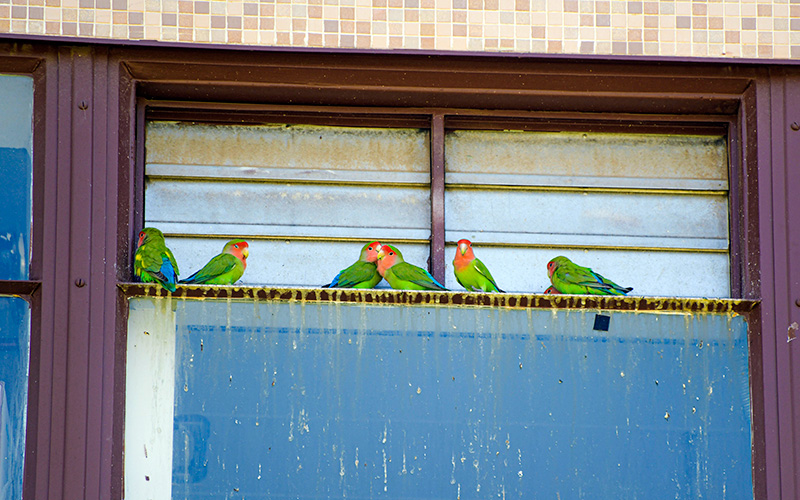PHOENIX – Rosy-faced lovebirds bring a splash of color to the Arizona desert, with neon green feathers and vibrant peach faces. The nonnative birds, which first appeared in Arizona about 40 years ago, have learned how to use human innovation to keep cool when temperatures soar.
Their ability to survive in Arizona is linked to urban development, according to a recent study at Arizona State University. For example, lovebirds on the Tempe campus began perching in air-conditioning vents that leak cool air.
Kevin Mcgraw and Raegan Mills spent a year studying the birds’ behavior and perching patterns at the Life Sciences Building. The research showed the birds often spent time in the vents when their temperature threshold hit upper limits.
“There’s a threshold once it certainly gets into the mid to high 90s that things start to get difficult for the lovebirds to cope,” McGraw said. “I think they need water and they need to cool down. The birds basically are standing in the window vents and just getting a cool breeze.”
According to McGraw and Mill’s research, there were more lovebirds in the vents when the temperature reached 98.6 degrees Fahrenheit or higher. During summer months, the National Weather Service says, Phoenix averages about 95 degrees, but temperatures frequently spike well into the 100s.
Mills said they proved that the surfaces where the birds perched were cool, and that the birds visited most frequently on “really hot” days.
“It was really fascinating to look at why specifically they were there, and (we) assumed that it was because they were getting some sort of benefit from the HVAC,” Mills said.

Rosy-faced lovebirds are small, noisy, gregarious parrots originally from Southwest Africa, with neon green feathers and vibrant peach faces. (Photo courtesy of Samantha Lloyd)
History of rosy-faced lovebirds in Arizona
Rosy-faced lovebirds (Agapornis roseicollis) are small, chirpy, gregarious parrots originally from Southwest Africa. How they came to flourish in metro Phoenix is something of an urban legend. Researchers and bird watchers have varying accounts, but most agree these birds at one point were pets and somehow escaped or were released. No one can say for sure.
Mark Larson, the president of the Maricopa Audubon Society, said lovebirds have expanded their populations throughout the Valley since the 1980s, but they’re unevenly distributed in small colonies.
McGraw said it appears the lovebirds have expanded their range but remain close to human development.
“They are fairly restricted to the city limits, and it looks like they’re heavily reliant on consistently available water, so water is key,” he said, adding that lovebirds can be seen at the fountain in front of Old Main.
Average temperatures in Arizona have risen more than 3 degrees Fahrenheit since 1970, according to Climate Central, and it’s considered one of the fastest-warming cities in the nation. In addition, long term drought continues, and both trends threaten rosy-faced lovebirds.
“As the water crisis continues, Colorado River restrictions, kind of the downstream effects on us and wildlife, certainly could directly hit the lovebirds,” McGraw said. “The water crisis could have a negative impact on the birds, but it might in turn benefit some other organisms if there aren’t as many lovebirds.”
According to the U.S. Drought Monitor, 34% of Arizona is in severe or exceptional drought. Lake Powell, which supplies much of Arizona with water, reached critically low levels earlier this year, as did Lake Mead further downstream.
Scientists like McGraw are concerned if the lovebirds continue to expand their population, they could become an invasive species. The U.S. Fish and Wildlife Service describes an invasive species as one that’s nonnative and capable of causing economic damage or harming human health or the environment.
“They’re beautiful in a lot of ways, but they also potentially could do some harm,” McGraw said. “I think there’s a little bit of circumstantial evidence that they can out-compete native species for certain nesting habitats. They’ll certainly feed at certain feeders that might displace other smaller, more shy birds.”
Studying the lovebirds was “a call to action” for Mills, to look at the impact of climate change on both nonnative and native animals. Mills said as the climate changes “we are completely changing” the environment for the species that live in it.
“As the climate continues to change the way that it is, we are pushing all sorts of species to interact with us in ways that they would never have before,” Mills said.
Mills is a genetic and developmental biology major, but the lovebirds were the “highlight” of the day when Mills worked on the study, observing the birds outside.
Mills said people have a responsibility to the lovebirds because we introduced them into Arizona.
“Not to say that we don’t also have a responsibility to wildlife that was indigenous to that area but there’s a certain kind of responsibility that we have to them because they are in such a huge part reliant on us to continue being around,” Mills said.
Share where you’ve seen lovebirds this season
Click the blue “+” in the upper right corner of the map to pin the location you’ve seen lovebirds this season. If you use the “Map Select Location” option to place your pin, you may need to shift the window to access the “Submit” button. Click and hold your mouse button on the gray “Add Entry” bar to move the window. The “Submit” option will appear on the bottom.


